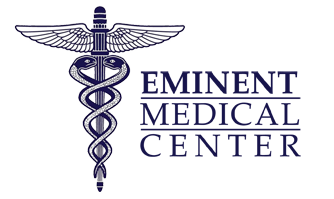Mako Total Hip Replacement Richardson, TX


What is Mako Smart Robotics?
Mako Smart Robotics revolutionizes orthopedic surgery by enhancing the precision and personalization of joint replacement procedures. This technology integrates advanced 3D imaging with robotic assistance, enabling surgeons to plan and execute prosthetic joint surgeries with exceptional accuracy. The system generates a detailed 3D model of a patient’s anatomy, and allowing for a tailored surgical approach.
During hip prosthesis surgery, the robotic arm ensures precise hip implant placement and minimal impact on surrounding tissues alongside the orthopaedic surgeon. The benefits include a more natural-feeling hip joint, reduced recovery time, and improved surgical outcomes, making Mako a significant advancement in joint replacement surgery technology.
What is a Total Hip Replacement?
A total hip replacement, also called total hip arthroplasty, addresses a damaged bone or diseased hip joint, replacing the bone joint with an artificial joint. Both total and partial hip replacement procedures are typically outpatient procedures performed at a hospital or surgery center. Hip replacement surgery is primarily aimed at relieving pain and improving mobility in individuals suffering from traumatic arthritis or other debilitating hip conditions.
Total Hip Replacement vs Partial Hip Replacement
There are two main types of hip replacements: partial and total. In a partial hip replacement, only the ball of the hip joint (also known as the femoral head) is replaced. Meanwhile, in a total hip arthroplasty, both the ball and socket joint are replaced with a hip prosthesis.
Anterior vs Posterior Hip Replacement
An orthopaedic surgeon at Eminent Medical Center can access the hip from different angles:
- Front (anterior approach to hip replacement)
- Side (lateral approach to hip replacement)
- Back (posterior approach to hip replacement)
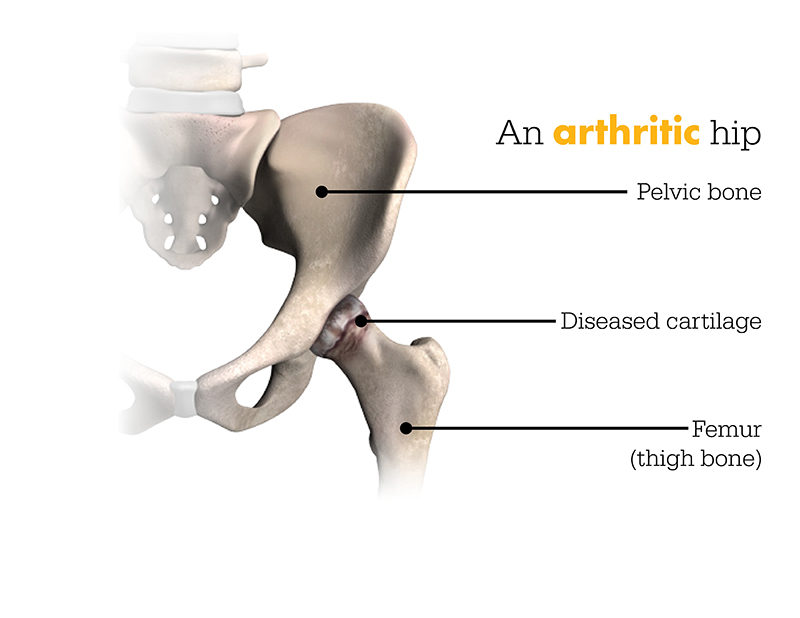
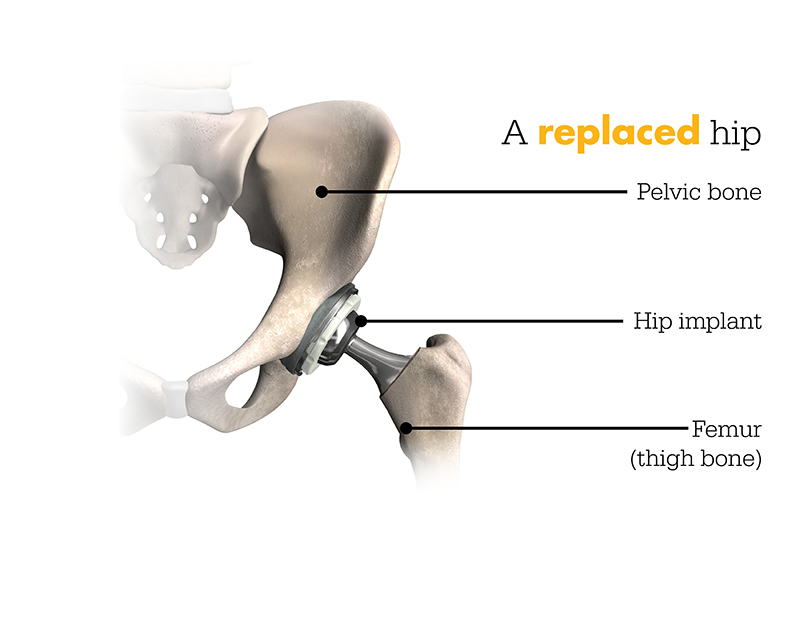
Hip Joint Artificial Implants Used in Total Hip Arthroplasty
During hip replacements, various materials are used to create one or both parts of the artificial joint, each with unique properties:
Metal-on-Polyethylene:
This traditional combination involves a metal ball fitting into a plastic (polyethylene) cup.
Ceramic-on-Polyethylene:
Ceramic is known for its smoothness and resistance to wear, potentially extending the lifespan of the hip replacement implant.
Ceramic-on-Ceramic:
This option is renowned for its exceptional wear resistance and longevity, making it a popular choice for younger, more active patients.
Ceramic-on-Metal:
This pairing combines a ceramic ball with a metal stem and cup, providing a balance between the smoothness of ceramic and the strength of metal.
Reasons for Hip Replacement
Total hip replacement surgeries are a common and highly effective procedure for individuals facing various hip-related health issues. These conditions can lead to severe hip pain, reduced mobility, and a significant decline in the quality of life, making a prosthetic hip a necessary choice for many experiencing one of these several factors.
- Osteoarthritis is a degenerative bone joint disease is the most frequent cause, leading to damaged cartilage and underlying hip joint.
- Rheumatoid Arthritis is an autoimmune disorder that causes chronic inflammation of the bone joint, including the hip joint, leading to severe pain and stiffness.
- Osteonecrosis or avascular necrosis results when there is inadequate blood supply to the ball portion of the hip joint, causing the bone to collapse and deteriorate.
- Hip Dislocation or Fracture: Severe or recurring hip fractures and dislocations often necessitate hip replacements.
- Bone Tumors: Tumors in or around the hip joint can erode the bone, necessitating a hip replacement to maintain functionality and relieve pain.
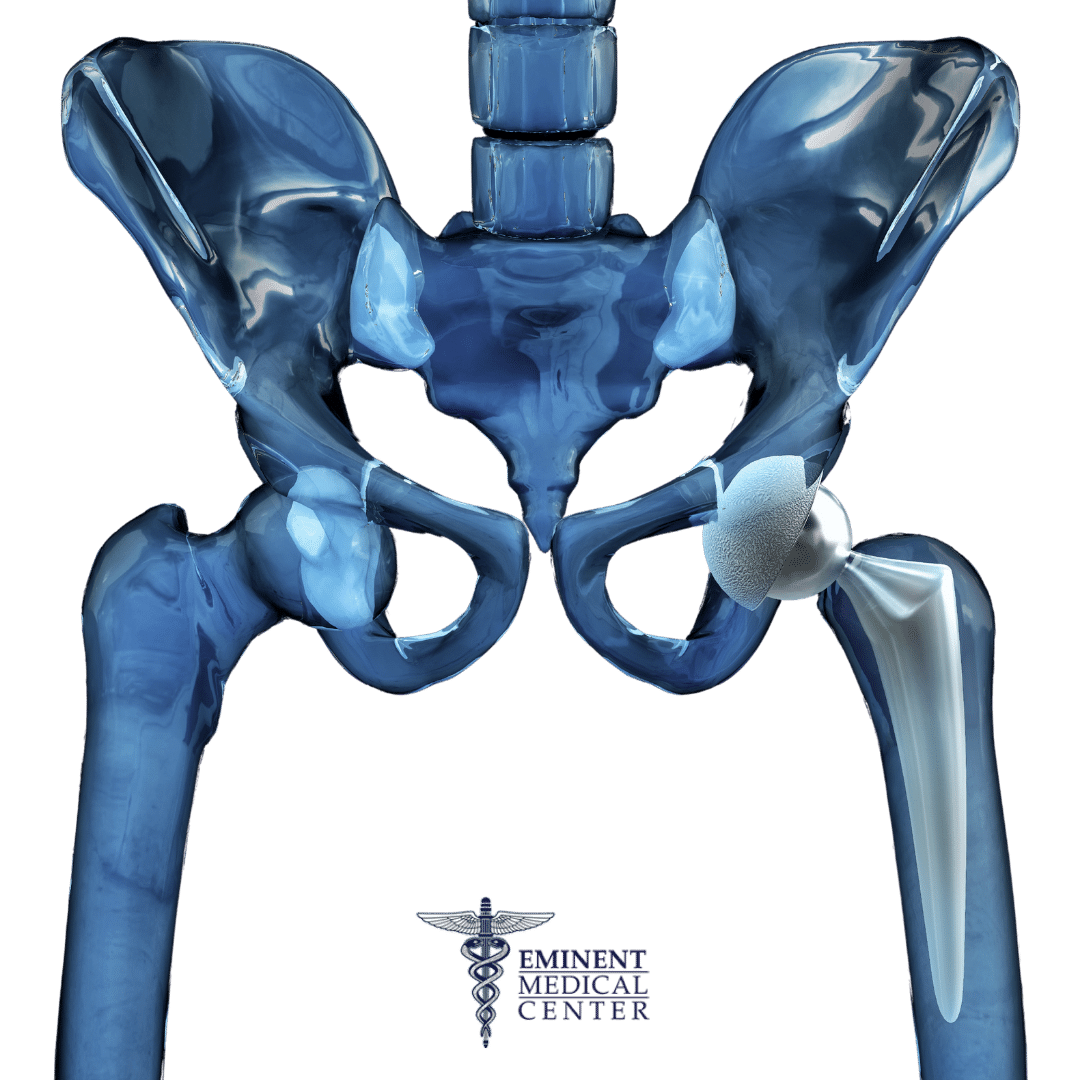
Benefits of Mako Total Hip Replacement
The benefits of undergoing a total hip replacement surgery with Mako Smart Robotics are numerous, profoundly impacting the overall success of hip replacements. This advanced technology offers unparalleled precision for total hip replacements, enhancing the effectiveness of the hip replacement implant. The following key advantages highlight why Mako Smart Robotics is a preferred choice for hip replacements:
Higher Accuracy
The precision of Mako Smart Robotics allows for more accurate placement of the hip implant. This accuracy is crucial in ensuring the longevity and effectiveness of the hip replacement, reducing the risk of complications associated with misalignment or improper positioning of the implant.
Better Total Hip Replacement Results
The use of Mako robotic technology in hip replacements often results in better surgical outcomes. Patients typically experience less pain post-surgery, a shorter hospital stay, and a quicker return to daily activities. The precise placement of the implant also means a more natural feeling in the hip post-surgery.
Faster Hip Replacement Recovery
With Mako Smart Robotics, the surgery is less invasive, and the surrounding tissues are better preserved. This leads to a quicker and less painful recovery process, allowing patients to regain mobility and return to their regular routine more rapidly with the equivalent of a healthy hip.
How Total Hip Replacement Arthroplasty Works With Mako Smart Robotics
The Mako Smart Robotics total hip replacement is a cutting-edge procedure that revolutionizes the traditional approach to hip surgery. The process involves a CT scan, a surgical plan, and the Richardson total joint surgery itself. Each of these steps plays a vital role in making the Mako Smart Robotics total hip replacement a highly successful and patient-focused procedure, available at Eminent Medical Center.
1
CT Scan
The process begins with a detailed medical history of the patient as well as a CT scan of the patient’s hip, which is used to generate a 3D model. This model helps the orthopedic surgeon in creating a personalized pre-operative plan, tailored specifically to the patient’s anatomy.
2
Surgical Plan
Using the 3D model, the surgeon develops a detailed surgical plan. This plan outlines the size, placement, and alignment of hip implants, ensuring a fit that is customized to the patient’s unique anatomy.
3
Surgical Procedure
During the surgery, the orthopaedic surgeon uses the Mako robotic arm to assist in removing the damaged cartilage and bone. The robot provides real-time feedback, ensuring that the procedure follows the pre-operative plan accurately, thus enhancing the precision of the implant placement.
What Happens During a Mako Total Hip Replacement Surgery?
Hip replacements are performed in a Eminent’s state-of-the-art surgery center. A common total hip replacement surgery has the following steps.
- Once in the operating room, you will get an intravenous (IV) line in your hand or arm. A urinary catheter may be inserted as well.
- You will receive either general anesthesia, an epidural, or spinal block.
- The surgeon will remove femoral head and open top of the femur. They will then insert the femoral stem of the ball prosthesis. The replacement head be attached to the top of the femur implant.
- The surgeon will then remove the damaged cartilage from the acetabulum (the bone joint socket) and attach the new cup, bending the leg to ensure proper function.
- Layers of tissue will be closed with dissolvable stitches that dissolve. Stitches won’t need to be removed after your hip arthroplasty.
- You will be taken to the recovery room and then transferred to a hospital room.
How It Works
Patient Story
Treating Arthritis with Mako
Total Hip Replacement Precautions
Total hip replacement surgery, like any major surgical procedure, carries certain risks and potential complications. Some of the potential common complications include:
- Infection: Although rare, there is a risk of infection at the surgery site or in the deeper tissue near the new hip.
- Blood Clots: The formation of blood clots in the leg veins or near pelvic bone is a possible complication, so many patients are instructed to take blood thinning medications prior to surgery. We may advise taking blood thinners for several weeks after hip replacement surgery, depending on outcomes of blood tests.
- New Hip Implant Dislocation or Loosening: The new hip joint may dislocate or become loose, potentially requiring further surgery.
- Fracture: During the operation, there could be small fractures in the surrounding bone, possibly necessitating additional surgical interventions.
- Nerve Damage: Nerves in the area surrounding the artificial hip might be damaged during surgery.
- Leg Length Inequality: There may be a difference in leg length, although this is rare and minor.
It’s crucial for patients considering total hip replacement surgery to discuss these risks thoroughly with their Richardson orthopedic surgeon at Eminent Medical Center.
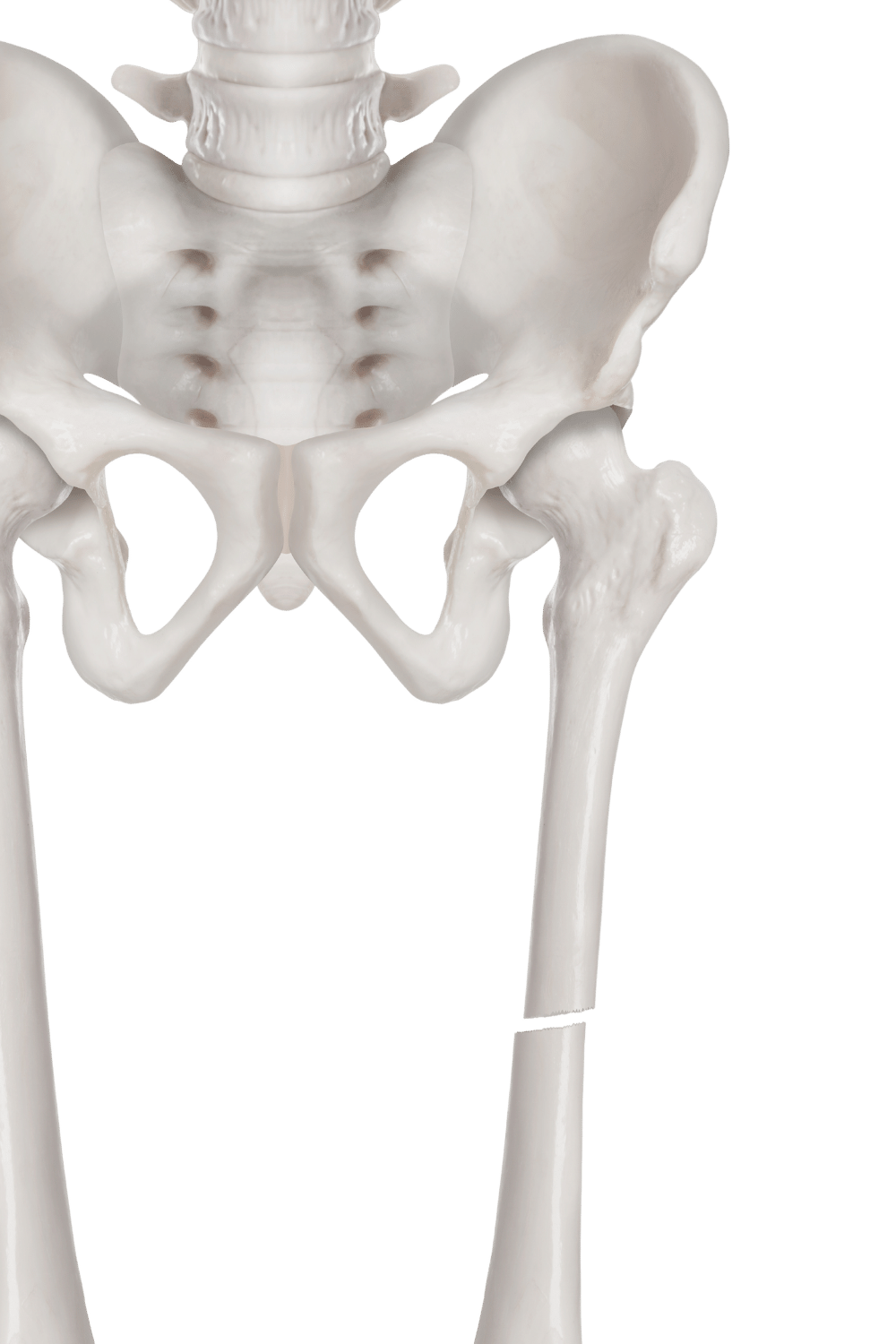
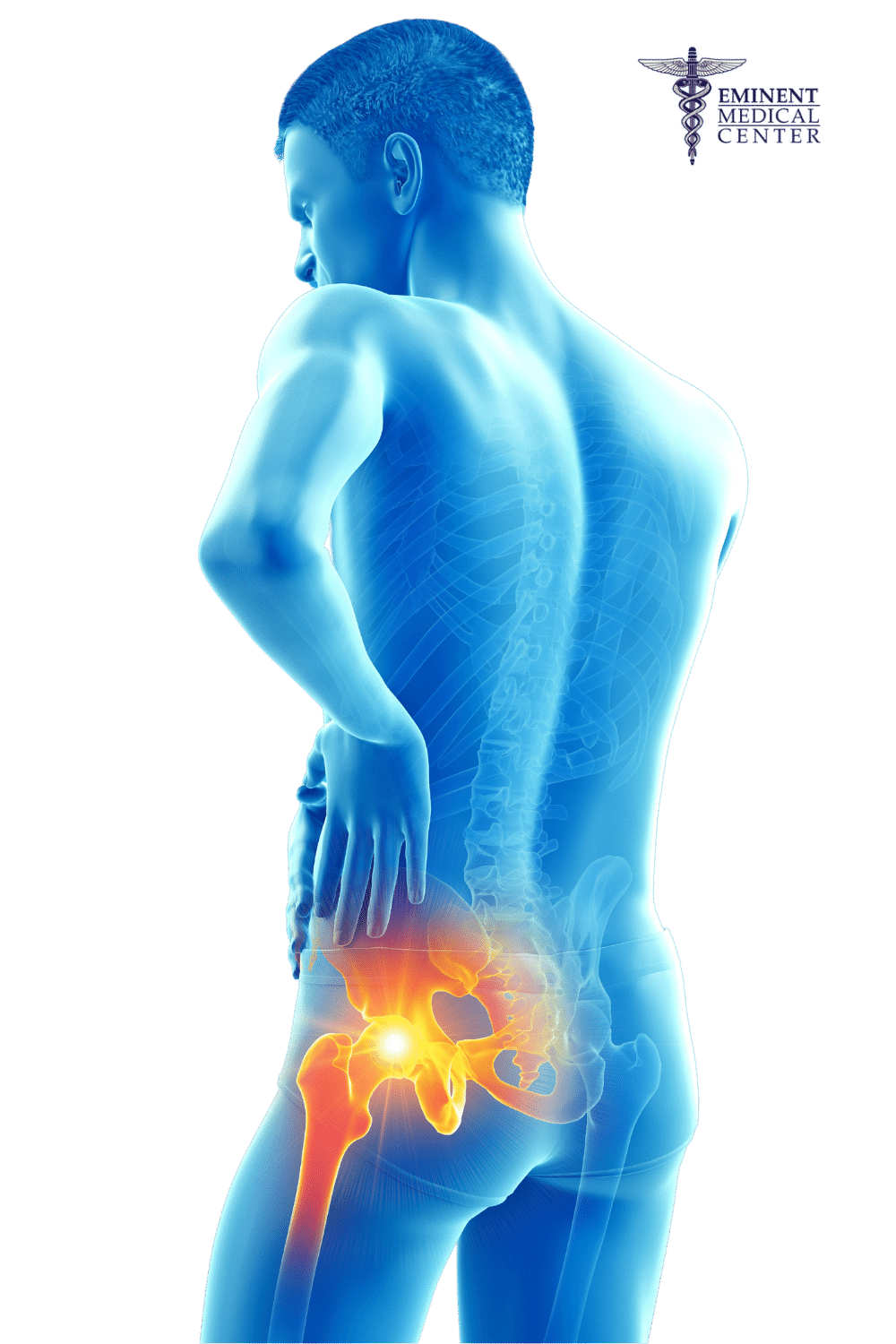
Total Hip Replacement Recovery at Eminent Medical Center
After undergoing Richardson orthopedic surgery at Eminent Medical Center, patients can expect a structured, full recovery process. Here’s an overview of what to expect during the first several weeks of the recovery period:
- Immediate Post-Operative Period: Initially, patients will be closely monitored to manage pain and prevent complications in the recovery room. This may include medications, physical therapy, and regular assessments.
- Rehabilitation: Physical therapy plays a crucial role in total hip replacement recovery, starting as soon as possible post-surgery to aid in regaining mobility and strength. A physical therapist will help patients initially focus on gentle exercises and gradually increase in intensity.
- Pain Management: Effective Richardson pain management strategies will be implemented to ensure comfort and facilitate an active rehabilitation process.
- Follow-Up Appointments: Follow-up appointments are scheduled to ensure full recovery, assess hip replacement functionality, and offer other treatments to address any concerns.
- Long-term Care and Guidance: Patients will receive detailed guidance on lifestyle adjustments to optimize long-term outcomes.
Total Hip Replacement Recovery Time
Following total hip arthroplasty, most patients can expect to feel good as new in 8 to 12 weeks, and many will no longer have to rely on nonsteroidal anti-inflammatory drugs to get through their days.
Mako Total Hip Replacement Surgery Center in Richardson, Texas
At Eminent Medical Center, our orthopaedic surgeons are committed to providing our patients with the highest standard of care using the latest medical advancements, like Mako total hip replacements. If you are experiencing hip pain or mobility issues and are considering getting your hips replaced, we encourage you to schedule an appointment with us today.
By choosing Eminent Medical Center for your joint replacement, you are opting for a facility that prioritizes your health, well-being, and a swift return to your daily activities. Contact us today at 469-910-8800 to take the first step in your journey to recovery.
At Eminent Medical Center, we prioritize your well-being, comfort, and recovery. We believe in the power of personalized care and will work closely with you to create a tailored treatment plan that meets your unique needs and goals. Whether you require a hip replacement, knee replacement, or shoulder replacement, our state-of-the-art facilities and experienced medical professionals are here to support you at every step of your journey.
Don’t let joint pain hold you back from living your best life. Take the first step towards a pain-free and more active future by contacting Eminent Medical Center today. Our team is ready to answer your questions, address your concerns, and schedule your consultation with our skilled orthopedic specialists. Contact us today at 469-910-8800 and let us help you reclaim your mobility and vitality through total joint surgery in Richardson, TX.
Important Information
Hip replacement is intended for use in individuals with joint disease resulting from degenerative and rheumatoid arthritis, avascular necrosis, fracture of the neck of the femur or functional deformity of the hip.
Hip replacement surgery is not appropriate for patients with certain types of infections, any mental or neuromuscular disorder which would create an unacceptable risk of prosthesis instability, prosthesis fixation failure or complications in postoperative care, compromised bone stock, skeletal immaturity, severe instability of the joint, or excessive body weight.
Like any surgery, joint replacement surgery has serious risks which include, but are not limited to, pain, infection, bone fracture, change in the treated leg length (hip), joint stiffness, hip joint fusion, amputation, peripheral neuropathies (nerve damage), circulatory compromise (including deep vein thrombosis (blood clots in the legs)), genitourinary disorders (including kidney failure), gastrointestinal disorders (including paralytic ileus (loss of intestinal digestive movement)), vascular disorders (including thrombus (blood clots), blood loss, or changes in blood pressure or heart rhythm), bronchopulmonary disorders (including emboli, stroke or pneumonia), heart attack, and death.
Implant related risks which may lead to a revision of the implant include dislocation, loosening, fracture, nerve damage, heterotopic bone formation (abnormal bone growth in tissue), wear of the implant, metal and/or foreign body sensitivity, soft tissue imbalance, osteolysis (localized progressive bone loss), audible sounds during motion, reaction to particle debris , and reaction to metal ions (ALTR). Hip and knee implants may not provide the same feel or performance characteristics experienced with a normal healthy joint.
The information presented is for educational purposes only. Speak to your doctor to decide if joint replacement surgery is appropriate for you. Individual results vary and not all patients will return to the same activity level. The lifetime of any joint replacement is limited and depends on several factors like patient weight and activity level. Your doctor will counsel you about strategies to potentially prolong the lifetime of the device, including avoiding high-impact activities, such as running, as well as maintaining a healthy weight. It is important to closely follow your doctor’s instructions regarding post-surgery activity, treatment and follow-up care. Ask your doctor if a joint replacement is right for you.
Stryker Corporation or its other divisions or other corporate affiliated entities own, use or have applied for the following trademarks or service marks: AccuStop, Mako, Stryker. All other trademarks are trademarks of their respective owners.
References
- Shibanuma N, Ishida K, Matsumoto T, et al. Early postoperative clinical recovery of robotic arm-assisted vs. image-based navigated Total hip Arthroplasty. BMC Musculoskelet Disord. 2021;22(1):314.
JR-MKOSYM-OTHW-747688
Copyright © 2023 Stryker

